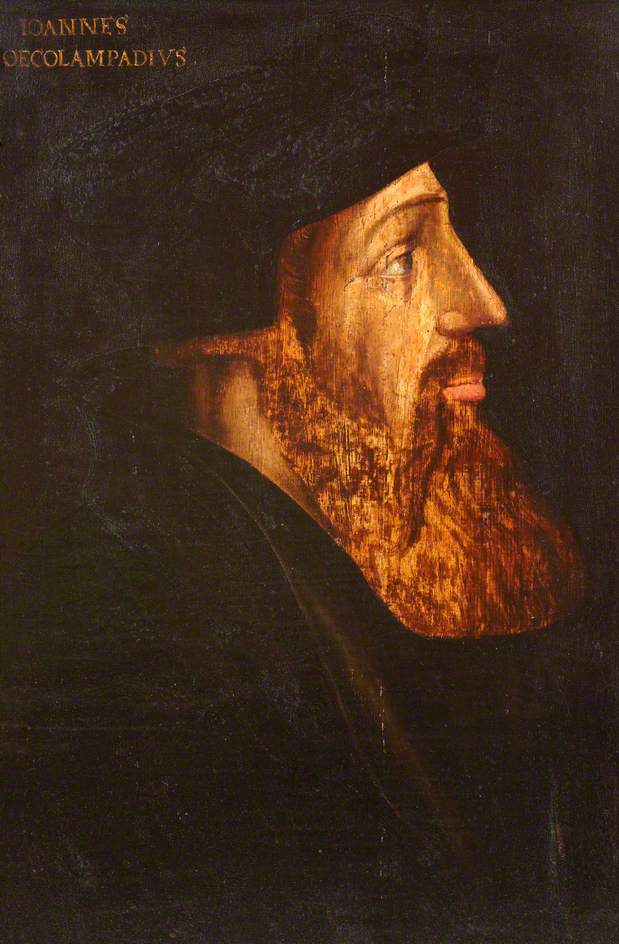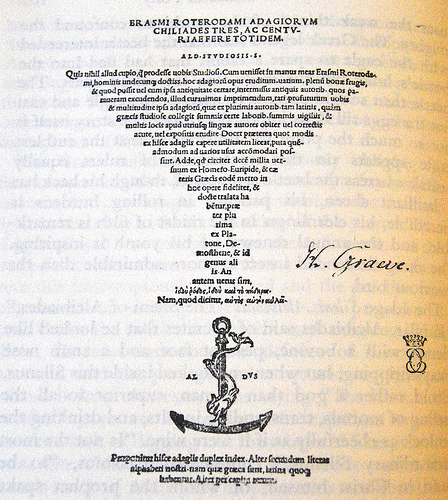|
Novum Instrumentum Omne
''Novum Instrumentum omne'' was the first published New Testament in Greek (1516). It was prepared by Desiderius Erasmus (1466–1536) and printed by Johann Froben (1460–1527) of Basel. Although the first printed Greek New Testament was the Complutensian Polyglot (1514), it was the second to be published (1516). Erasmus used several Greek manuscripts housed in Basel, but some verses in Revelation he translated from the Latin Vulgate. Five editions of ''Novum Instrumentum omne'' were published, although its title was changed to ''Novum Testamentum omne'' with the second edition, and the name continued. Erasmus issued editions in 1516, 1519, 1522, 1527, and 1536. Notable amongst these are the second edition (1519), used by Martin Luther for his translation of the New Testament into German (the so-called "September Testament"), and the third edition (1522), which was used by William Tyndale for the first '' English New Testament'' (1526) and later by translators of the Geneva B ... [...More Info...] [...Related Items...] OR: [Wikipedia] [Google] [Baidu] |
Geneva Bible
The Geneva Bible is one of the most historically significant translations of the Bible into English, preceding the King James Version by 51 years. It was the primary Bible of 16th-century English Protestantism and was used by William Shakespeare, Oliver Cromwell, John Knox, John Donne, and others. It was one of the Bibles taken to America on the ''Mayflower'' (Pilgrim Hall Museum has collected several Bibles of ''Mayflower'' passengers). The Geneva Bible was used by many English Dissenters, and it was still respected by Oliver Cromwell's soldiers at the time of the English Civil War, in the booklet ''The Souldiers Pocket Bible''. This version of the Bible is significant because, for the first time, a mechanically printed, mass-produced Bible was made available directly to the general public which came with a variety of scriptural study guides and aids (collectively called an apparatus), which included verse citations that allow the reader to cross-reference one verse with num ... [...More Info...] [...Related Items...] OR: [Wikipedia] [Google] [Baidu] |
Book Of Revelation
The Book of Revelation is the final book of the New Testament (and consequently the final book of the Christian Bible). Its title is derived from the first word of the Koine Greek text: , meaning "unveiling" or "revelation". The Book of Revelation is the only apocalyptic book in the New Testament canon. It occupies a central place in Christian eschatology. The author names himself as simply "John" in the text, but his precise identity remains a point of academic debate. Second-century Christian writers such as Papias of Hierapolis, Justin Martyr, Irenaeus, Melito of Sardis, Clement of Alexandria, and the author of the Muratorian fragment identify John the Apostle as the "John" of Revelation. Modern scholarship generally takes a different view, with many considering that nothing can be known about the author except that he was a Christian prophet. Modern theological scholars characterize the Book of Revelation's author as " John of Patmos". The bulk of traditional s ... [...More Info...] [...Related Items...] OR: [Wikipedia] [Google] [Baidu] |
Minuscule 1
Codex Basilensis A. N. IV. 2, ''Minuscule 1'' (on the list of Gregory-Aland), δ 254 (in von Soden's numbering) and formerly designated by 1eap to distinguish it from minuscule 1rK (which previously used number 1) is a Greek minuscule manuscript of the New Testament, usually dated palaeographically to the 12th century CE. It contains the entire New Testament apart from the Book of Revelation. The codex was prepared for liturgical use with marginalia (text division), and has almost completely survived; Erasmus used it for his ''Novum Instrumentum omne''. The text of the manuscript has been cited in all critical editions of the Greek New Testament; in this codex, the text of the Gospels is more highly esteemed by scholars than that of the remaining New Testament books. The codex is housed at the Basel University Library, with shelf number A. N. IV, 2 (earlier B. VI. 27). Description The codex contains the entire New Testament (except of Book of Revelation) in the following o ... [...More Info...] [...Related Items...] OR: [Wikipedia] [Google] [Baidu] |
Johannes Oecolampadius
Johannes Oecolampadius (also ''Œcolampadius'', in German also Oekolampadius, Oekolampad; 1482 – 24 November 1531) was a German Protestant reformer in the Calvinist tradition from the Electoral Palatinate. He was the leader of the Protestant faction in the Baden Disputation of 1526, and he was one of the founders of Protestant theology, engaging in disputes with Erasmus, Zwingli, Luther and Martin Bucer. Calvin adopted his view on the Eucharist dispute ( against Luther). His German surname was ''Hussgen'' (or ''Heussgen'', ''Huszgen''), which he etymologized to ''Hausschein'' ("house-shine") and graecized (as was the custom at the time) to Οἰκολαμπάδιος in all capital letters, without Greek diacritics, as may be seen in , quoting a verse of Johannes Rhellicanus. In modern times, his name has been published in lowercase using polytonic diacritics, viz. ( grc-gre, Οἰκολαμπάδιος) in ''katharevousa'' publications associated with the Greek Orthodo ... [...More Info...] [...Related Items...] OR: [Wikipedia] [Google] [Baidu] |
Samuel Prideaux Tregelles
Samuel Prideaux Tregelles (30 January 1813 – 24 April 1875) was an English biblical scholar, lexicographer, Christian Hebraist, textual critic, and theologian. Life Tregelles was born at Wodehouse Place, Falmouth, of Quaker parents, but he himself was for many years in communion with the Plymouth Brethren and then later in life became a Presbyterian (or perhaps an Anglican). He was the son of Samuel Tregelles (1789–1828) and his wife Dorothy (1790–1873) and was the nephew of Edwin Octavius Tregelles. He was educated at Falmouth classical school from 1825 to 1828. For a time Tregelles worked at the ironworks, Neath Abbey, Glamorgan, where he devoted his spare time to learning Greek, Hebrew, Aramaic, and Welsh. His interest in Welsh developed from a desire to spread the Christian gospel and especially to combat the influence of atheism, Roman Catholicism, and Mormonism in Wales. Tregelles became a private tutor in Falmouth, and finally devoted himself to schola ... [...More Info...] [...Related Items...] OR: [Wikipedia] [Google] [Baidu] |
Bruce Metzger
Bruce Manning Metzger (February 9, 1914 – February 13, 2007) was an American biblical scholar, Bible translator and textual critic who was a longtime professor at Princeton Theological Seminary and Bible editor who served on the board of the American Bible Society and United Bible Societies. He was a scholar of Greek, New Testament, and New Testament textual criticism, and wrote prolifically on these subjects. Metzger was one of the most influential New Testament scholars of the 20th century. He was elected to the American Philosophical Society in 1986. Biography Metzger was born on February 9, 1914, in Middletown, Pennsylvania, and earned his BA (1935) at Lebanon Valley College. Metzger had strong academic training in Greek before enrolling in Princeton Seminary, and in the summer prior to entering the Seminary, he completed reading through the entire Bible consecutively for the twelfth time. He received his ThB in 1938 at Princeton Theological Seminary, and in the autum ... [...More Info...] [...Related Items...] OR: [Wikipedia] [Google] [Baidu] |
Alexandrian Text-type
In textual criticism of the New Testament, the Alexandrian text-type is one of the main text types. It is the text type favored by the majority of modern textual critics and it is the basis for most modern (after 1900) Bible translations. Over 5,800 New Testament manuscripts have been classified into four groups by text type. Besides the Alexandrian, the other types are the Western, Caesarean, and Byzantine. Compared to these later text types, Alexandrian readings tend to be abrupt, use fewer words, show greater variation among the Synoptic Gospels, and have readings that are considered difficult. That is to say, later scribes tended to polish scripture and improve its literary style. Glosses would occasionally be added as verses during the process of copying a Bible by hand. From the ninth century onward, most surviving manuscripts are of the Byzantine type. The King James Version and other Reformation-era Bibles are translated from the '' Textus Receptus'', a Greek text creat ... [...More Info...] [...Related Items...] OR: [Wikipedia] [Google] [Baidu] |
Adagia
''Adagia'' (singular ''adagium'') is the title of an annotated collection of Greek and Latin proverbs, compiled during the Renaissance by Dutch humanist Desiderius Erasmus Roterodamus. Erasmus' collection of proverbs is "one of the most monumental ... ever assembled" (Speroni, 1964, p. 1). The first edition, titled ''Collectanea Adagiorum'', was published in Paris in 1500, in a slim quarto of around eight hundred entries. By 1508, after his stay in Italy, Erasmus had expanded the collection (now called ''Adagiorum chiliades tres'' or "Three thousands of proverbs") to over 3,000 items, many accompanied by richly annotated commentaries, some of which were brief essays on political and moral topics. The work continued to expand right up to the author's death in 1536 (to a final total of 4,151 entries), confirming the fruit of Erasmus' vast reading in ancient literature. Commonplace examples from ''Adagia'' Some of the adages have become commonplace in many European languag ... [...More Info...] [...Related Items...] OR: [Wikipedia] [Google] [Baidu] |
Jerome
Jerome (; la, Eusebius Sophronius Hieronymus; grc-gre, Εὐσέβιος Σωφρόνιος Ἱερώνυμος; – 30 September 420), also known as Jerome of Stridon, was a Christian priest, confessor, theologian, and historian; he is commonly known as Saint Jerome. Jerome was born at Stridon, a village near Emona on the border of Dalmatia and Pannonia. He is best known for his translation of the Bible into Latin (the translation that became known as the Vulgate) and his commentaries on the whole Bible. Jerome attempted to create a translation of the Old Testament based on a Hebrew version, rather than the Septuagint, as Latin Bible translations used to be performed before him. His list of writings is extensive, and beside his biblical works, he wrote polemical and historical essays, always from a theologian's perspective. Jerome was known for his teachings on Christian moral life, especially to those living in cosmopolitan centers such as Rome. In many cases, he ... [...More Info...] [...Related Items...] OR: [Wikipedia] [Google] [Baidu] |
Vulgate
The Vulgate (; also called (Bible in common tongue), ) is a late-4th-century Latin translation of the Bible. The Vulgate is largely the work of Jerome who, in 382, had been commissioned by Pope Damasus I to revise the Gospels used by the Roman Church. Later, on his own initiative, Jerome extended this work of revision and translation to include most of the books of the Bible. The Vulgate became progressively adopted as the Bible text within the Western Church. Over succeeding centuries, it eventually eclipsed the . By the 13th century it had taken over from the former version the designation (the "version commonly used") or for short. The Vulgate also contains some ''Vetus Latina'' translations which Jerome did not work on. The Vulgate was to become the Catholic Church's officially promulgated Latin version of the Bible as the Sixtine Vulgate (1590), then as the Clementine Vulgate (1592), and then as the '' Nova Vulgata'' (1979). The Vulgate is stil ... [...More Info...] [...Related Items...] OR: [Wikipedia] [Google] [Baidu] |

_School_-_Sir_Rowland_Hill_(1492–1561)_-_1298284_-_National_Trust.jpg)

_f_1r.jpg)





.jpg)